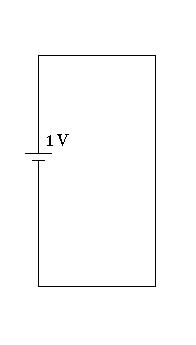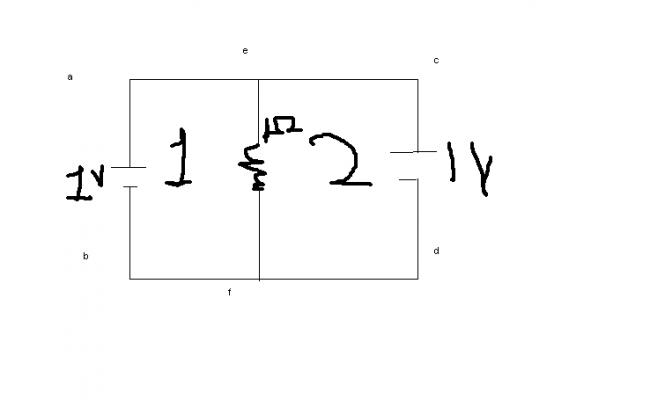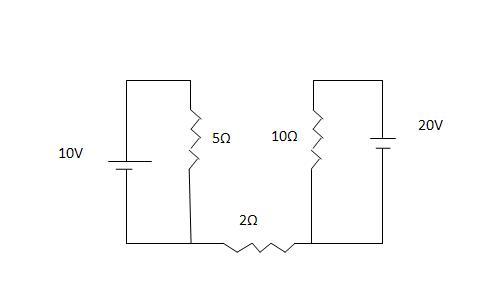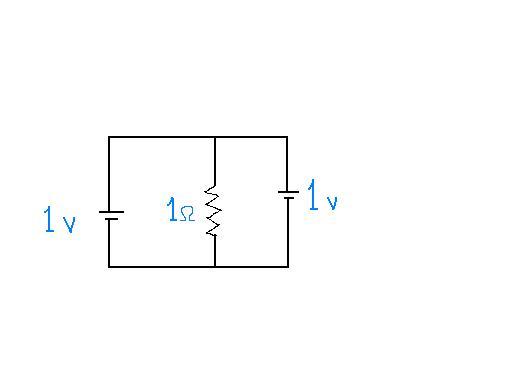 1
1Also 1 more point ... how can 1 even calculate the current in 2Ω resistance !!!
Lets forget the logic I gave above.
The 2 batteries produces only potential difference of 10V & 20V.
How can 1 say anything about the potential difference across the 2Ω resistance when the absolute potential of negative plates of batteries are not known !!
Please share the other solutions which you have found somewhere else.
That will be good for clearing doubts
 1
1the potential at the up and down junction of the wires will be zero. so the p.d. is zero. so no current.
 24
24@ priyam, in the circuit u have posted,just remember that both circuits are disjoint(joined by single wire),so current through 2 ohm=0
 1
1heyy what is milmans law?cud sum1 explain?
 62
62
Apply KCL here...
Can u?
Does KCL gets violated
Why??
That is the same reason why it cannot be applied in this question either!!!!
Basically it is not an issue with KCL.. The issue is with the practicality of such circuits!
 1
1oh yeah you're right.
one mo , I'll have to reconstruct ma argument.
 1
1net e.m.f will be ε1r2 + ε2r1 / r1+r2
if the negative terminal of one battery is connected with positive terminal of another battery than net emf will be ε1r2 - ε2r1 / r1+r2
 33
33So will it be zero for this (current through 2 ohm).....(IIT 2005) (above second question)
 1
1I forgot , U've still got ot write the law for the loop contianing both the batteries.?
 1
1if we have two batteries in parallel ,then the net EMF produced is given by ε1r2 - ε2r1 / r1+r2
but here r1 =r2 = 0 , lets' assume they have an internal resistance R , even then e1 -e2 is zero , so the net EMF is zero , so current flowing is zero .
 1
1if i am not wrong then then kirchoff's laws are are applicable every where. Still if i am wrong plz reply
 1
1Lets divide the circuit
Applying kichoff laws we get i1= 1a and i2 = 1a
therefore the net current is 2 a
 62
62This circuit cannot be solved.. basically bcos there will be infinite current flow...(this is by superposition!)
Current thru 1 ohm though will be 0.
The two sides are short circuits.. (bcos there is 0 resistance in the wires with the batteries)
 33
33I think u r right but at many places they give other answers but i think this is right....
 1
1Hey ... wont it be 0 ?
Say, If we take left part, assume current in the loop is I amps.
When we consider the junction at the left end of 2Ω resistence:-
Current coming from top is I & all of it should go to the 10V battery because I current is coming from battery.
Please tell me if I am wrong somewhere.
 33
33Oh from it i remembered..........
(IIT 2005)
Find current in 2 ohm resistance

Can't figure out?
 62
62btw u should try applying superposition principle instead.. That is bcos this is a much more elementary and basic principle...
u will get the result that i am talking about
 62
62reply in my previous post... (i knew this question was coming :D)
 1
1Why not try applying the theorem ??
 62
62Some results (a lot of them) use a few conditions.. those conditions are ignored at times...
like in Millman's proof.. the fact that all R's are non-zero has been forgotten .. bcos for all practical purposes.. that situation does not arise!
So u should not fall in the trap of Millman's for this problem.
 62
62But yes.. if an answre is asked for the current in the circuit in between.. the answer will be "zero"
read my first post ...
and also apply superposition to reach this result!
 62
62of course it goes with the fact that there are many many circuits u have/ may have solved where cells are put without internal resistance..
but here the case is slightly different
 62
62basically u can apply no theorem here..
that is bcos this ciruit is theoretically wrong.!!
It is a case of short circuit!
bcos practically all wires have some resistance..
and all cells have an internal resistance...
if u tried to solve it .. u wud get an answer of 2 without much diffficulty...
but the fact is that this circuit is not practical!
 1
1Can we not apply Millman's Theorem .........??
 Find the current through 1 ohm resistor :
Find the current through 1 ohm resistor :

